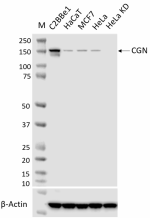- Clone
- W21116A (See other available formats)
- Regulatory Status
- RUO
- Other Names
- Cingulin, KIAA1319
- Isotype
- Rat IgG2a, κ
- Ave. Rating
- Submit a Review
- Product Citations
- publications

-

Whole cell extracts (15 µg total protein per lane) from the indicated cell lines were resolved on a 4-12% Bis-Tris gel, transferred to a PVDF membrane, and probed with 1.0 µg/mL of Purified anti-CGN (clone W21116A) overnight at 4°C. Proteins were visualized by chemiluminescence detection using HRP Goat anti-rat IgG (Cat. No. 405405) at a 1:5000 dilution. Direct-Blot™ HRP anti-β-actin (Cat. No. 664804) was used as a loading control at a 1:25000 dilution. Western-Ready™ ECL Substrate Premium Kit (Cat. No. 426319) was used as a detection agent. Lane M: Molecular weight marker -

C2BBe1 cells were fixed with Fixation Buffer (Cat. No. 420801) for 10 minutes, permeabilized with 0.5% Triton X-100, and blocked with 5% FBS for 1 hour at room temperature. Cells were then intracellularly stained with 2.0 µg/mL of Purified anti-CGN (clone W21116A), followed by incubation with 2.5 µg/mL of Alexa Fluor® 488 Goat anti-rat IgG (Cat. No. 405418) (green) for 1 hour at room temperature (panel A). Nuclei were counterstained with DAPI (Cat. No. 422801) (blue), and F-actin was counterstained with Flash Phalloidin™ Red 594 (Cat. No. 424203) (panel B). The image was captured with a 40X objective. Scale bar: 25 µm -

HeLa cells (mock) (panel A and B) and HeLa knockdown cells (panel C and D) were fixed with 4% paraformaldehyde for 10 minutes, permeabilized with ice-cold methanol, and blocked with 5% FBS for 1 hour at room temperature. Cells were then intracellularly stained with 5.0 µg/mL of Purified anti-CGN (clone W21116A), followed by incubation with 2.5 µg/mL of Alexa Fluor® 594 Goat anti-rat IgG (Cat. No. 405422) for 1 hour at room temperature. Nuclei were counterstained with DAPI (Cat. No. 422801) (panels B and D), and the image was captured with a 40X objective. Scale bar: 25 µm
| Cat # | Size | Price | Quantity Check Availability | Save | ||
|---|---|---|---|---|---|---|
| 624951 | 25 µg | 184€ | ||||
| 624952 | 100 µg | 364€ | ||||
CGN, found in the cytoplasmic plaque of tight junctions, is situated on the cytoplasmic side of tight junctions in polarized epithelia and certain endothelia. It is made up of a homodimer structure, with each subunit having a globular "head" section, a coiled-coil "rod" section, and a tiny globular "tail" section. Furthermore, CGN binds to JAM, ZO proteins, AF-6, and myosin, indicating its potential role in transmitting the mechanical energy produced by the contraction of the actomyosin cytoskeleton to the proteins of the cytoplasmic plaque and the membrane regions of TJs. Its main function is likely in the formation and control of the tight junction paracellular permeability barrier. Cingulin has additionally been discovered to engage with microtubules via the N-terminal head area, and these connections were governed by the process of phosphorylation by the adenosine monophosphate-activated protein kinase (AMPK). Moreover, the production of CGN in initial mouse embryos is specific to certain tissues, and it takes place in the blastocyst (increased in trophectoderm and decreased in inner-cells).
Product DetailsProduct Details
- Verified Reactivity
- Human
- Antibody Type
- Monoclonal
- Host Species
- Rat
- Immunogen
- Partial Recombinant human CGN protein
- Formulation
- Phosphate-buffered solution, pH 7.2, containing 0.09% sodium azide
- Preparation
- The antibody was purified by affinity chromatography.
- Concentration
- 0.5 mg/mL
- Storage & Handling
- The antibody solution should be stored undiluted between 2°C and 8°C.
- Application
-
WB - Quality tested
ICC - Verified - Recommended Usage
-
Each lot of this antibody is quality control tested by western blotting. For western blotting, the suggested use of this reagent is 0.125 - 1.0 µg/mL. For immunocytochemistry, a concentration range of 1.0 - 5.0 μg/mL is recommended. It is recommended that the reagent be titrated for optimal performance for each application.
- Application Notes
-
The clone does not cross-react with mouse.
For immunocytochemistry (ICC), the suggested fixation/permeabilization method is either 4% paraformaldehyde/0.5% Triton X-100 or paraformaldehyde followed by ice-cold methanol, or fixed with ice-cold methanol only.
This product is not recommended for use in immunohistochemistry. - Additional Product Notes
-
This antibody has been tested in knockout/knockdown models for Western Blotting and Immunocytochemistry.
Antigen Details
- Structure
- CGN protein is a 1203 amino acid protein with a predicted molecular weight of 137 kD
- Distribution
-
Pancreas, kidney, liver and lung, but not in skeletal muscle, placenta, brain or heart
- Function
- Formation and regulation of the tight junction
- Interaction
- TJP1/ZO1, SPEF1
- Cell Type
- Endothelial cells, Epithelial cells
- Biology Area
- Cell Biology, Cell Motility/Cytoskeleton/Structure
- Antigen References
-
- Cordenonsi M, et al. 1999. J Cell Biol. 147:1569–82.
- Bazzoni G, et al. 2000. J Biol Chem. 275:20520-6.
- Yano T, et al. 2013. J Cell Biol. 203: 605–14.
- Javed Q, et al. 1993. Development. 117:1145-51.
- Fleming TP, et al. 1993. Development. 117:1135-44.
- Gene ID
- 57530 View all products for this Gene ID
- UniProt
- View information about CGN on UniProt.org
Related FAQs
Other Formats
View All CGN Reagents Request Custom Conjugation| Description | Clone | Applications |
|---|---|---|
| Purified anti-CGN | W21116A | WB,ICC |
Compare Data Across All Formats
This data display is provided for general comparisons between formats.
Your actual data may vary due to variations in samples, target cells, instruments and their settings, staining conditions, and other factors.
If you need assistance with selecting the best format contact our expert technical support team.
 Login / Register
Login / Register 










Follow Us